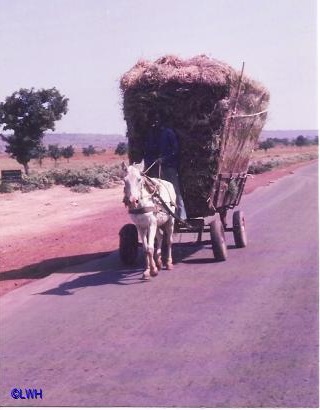
This photo was sent to me in an e-mail. It was taken near Segou. The gentleman who sent it said this was the only horse he saw that far south in Mali. He mentioned that he had noticed that horses were not too numerous below Mopti which is pretty far south as is Segou. I thought an article on Mali and its animals would be interesting. A thank you to "LWH" for the pictures you have provided and for your enlightenment about West Africa.
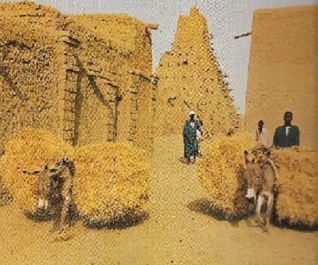
The image above was provided to me by LHW by e-mail. It appeared in a book, Au Coeur du Mali, (The Heart of Mali), by Michel Renaudeau, edited by the Commissariat au Tourisme. The photo was taken in ![]() Timbuktu, Mali. Timbuktu is a historical, cultural, Islamic, and European site of importance in terms of the exploration of Africa. Notice the use of donkeys in the image.
Timbuktu, Mali. Timbuktu is a historical, cultural, Islamic, and European site of importance in terms of the exploration of Africa. Notice the use of donkeys in the image.
For More Information on Timbuktu: Timbuktu/A UNESCO site
"Home of the prestigious Koranic Sankore University and other madrasas, Timbuktu was an intellectual and spiritual capital and a centre for the propagation of Islam throughout Africa in the 15th and 16th centuries. Its three great mosques, Djingareyber, Sankore and Sidi Yahia, recall Timbuktu's golden age. Although continuously restored, these monuments are today under threat from desertification...."
 Although LWH did not know the breed of the horse pictured above, looking at its conformation one can see that it is small, narrow through the chest, has thin but well defined legs, a well defined head with perky ears, wide apart eyes, and good sized nostrils. It is gray in color. Apparently it has endurace because it is pulling quite a load. I suspect that it comes from the West African Barb which is found in most regions of West Africa. The foundation breed of the West African Barb is the Barb. Most West African Barb horses are gray and small. Compare the two pictures and one can see that these two horses are from the same background.
Although LWH did not know the breed of the horse pictured above, looking at its conformation one can see that it is small, narrow through the chest, has thin but well defined legs, a well defined head with perky ears, wide apart eyes, and good sized nostrils. It is gray in color. Apparently it has endurace because it is pulling quite a load. I suspect that it comes from the West African Barb which is found in most regions of West Africa. The foundation breed of the West African Barb is the Barb. Most West African Barb horses are gray and small. Compare the two pictures and one can see that these two horses are from the same background.
It should not be confused with the Algerian, Moroccan or Tunisian Barb horses. They resemble the Pony Mousseye of Cameroon. The West African Donoga breed descended from the Dongola breed. Several names apply to these strain of West African horses. Fulani (across North Africa), Bahr-el-Ghazal (in Chad), and Hausa and Bornee (in Nigeria) Bandiagara, Djerma, Mossi, Songhai and Yagha (in Niger Bend).
Note: "The Maghreb...also rendered Maghrib, refers to five countries located in North Africa. It is an Arabic word, literally meaning "place of sunset" or "the west" (from an Arabian perspective). The term is generally now used, mainly by Arabs, to refer collectively to the African countries of Morocco, Algeria, Tunisia, Libya, Mauritania and the disputed territory of Western Sahara. However, before the establishment of modern nation states in the region in the 20th century, "Maghreb" signified the smaller area that lies between the high ranges of the Atlas Mountains in the south, and the Mediterranean Sea in the north, thus excluding most of Libya and all of current Mauritania. Sometimes, after Islam entered the region, the term has included the previously Muslim Andalusia, Sicily, and Malta." Maghreb
The Barb is a light riding horse which originated in the Maghreb region of northern Africa.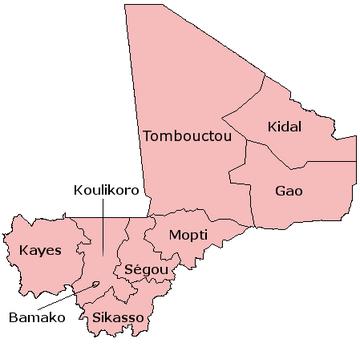
Regions of Mali
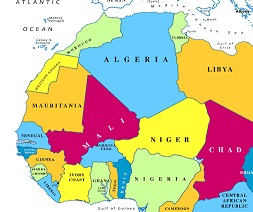
Land-locked Mali and seven surrounding countries.
Mali is land land-locked in West Africa and is bordered by seven African nations: Algeria, Mauritania, Senegal, Guinea, Ivory Coast, Burkina Faso, and Niger. Seventy percent of the people are agrarian, albeit, struggling and poor. The common faith is Muslim and the local language is Bambara. The official language is French; however, Mali is an ethnically diverse country with more than two dozen different groups. Each has its own language, dialect, traditions and beliefs. These varied ethnicities are passed along by dance, art, and song. Story tellers, are known as griots or bards. ("A griot...jali or jeli...is a West African historian, storyteller, praise singer, poet and/or musician. The griot is a repository of oral tradition, and is also often seen as something of a societal leader due to his traditional position as an adviser to royal personages. As a result of the former of these two functions, he is sometimes also called a bard. According to Paul Oliver in his book Savannah Syncopators, 'Though [the griot] has to know many traditional songs without error, he must also have the ability to extemporize on current events, chance incidents and the passing scene. His wit can be devastating and his knowledge of local history formidable'. Although they are popularly known as 'praise singers, griots may also use their vocal expertise for gossip, satire, or political comment. ...") Griots
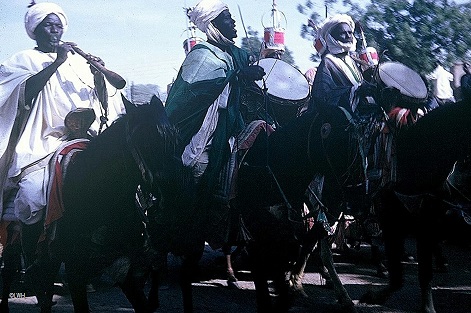
Fulani Horsemen/Musicans or Griots
"Griots today live in many parts of West Africa, and are present among the Mande peoples (Mandinka, Malinké, Bambara, etc.), ...Fula, Hausa, Songhai, Tukulóor, Wolof, Serer, Mossi, Dagomba, Mauritanian Arabs and many other smaller groups. The word may derive from the French transliteration 'guiriot' of the Portuguese word 'criado', or masculine singular term for 'servant'. These story-tellers are more predominant in the northern portions of West Africa. In African languages, griots are referred to by a number of names: jeli in northern Mande areas, jali in southern Mande areas, guewel in Wolof, gawlo in Pulaar (Fula). Griots form an endogamous caste, meaning that most of them only marry fellow griots and that those who are not griots do not normally perform the same functions that they perform."
See Also:
Western Sudan Pony aka Darfur Pony, Gharkawi or Kordofani Breed
